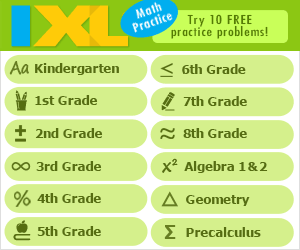6th Grade Data Analysis, Statistics, and Probability
To work on sicth grade geometry and measurement standards, click on the numbers below to visit pages with resources for each of the learning standards.
Checks for Understanding are at the top of this page. Scroll down to find internet resources related to the State Performance Indicators (SPIs).
Checks for Understanding (Formative/Summative Assessment)
Probability - Understand that the probability of an event is a number between zero and one that expresses the likelihood of its occurrence. 0606.5.2 Ratio - Identify the probability of an event as the ratio of the number of its actual occurrences to the total number of its possible occurrences. 0606.5.3 Expressing - Express probabilities in different ways. 0606.5.4 Odds - Understand the difference between probability and odds. 0606.5.5 Situations - Analyze a situation that involves probability of an independent event. 0606.5.6 Estimate - Estimate the probability of simple and compound events through experimentation or simulation. 0606.5.7 Calculate - Apply procedures to calculate the probability of complimentary events.
0606.5.8 Graphical - Connect data sets and their graphical representations (such as bar graphs, circle, graphs, and stem-and-leaf plots). 0606.5.9 Sample Space - Determine the sample space for a given situation. 0606.5.10 Random - Distinguish between a random and nonrandom sample. 0606.5.11 Center - Select the appropriate measure of center to describe a data set. 0606.5.12 Population - Predict the characteristics of a population based on the analysis of sample data.
State Performance Indicators
SPI 0606.5.1 Theoretical - Determine the theoretical probability of simple and compound events in familiar contexts. SPI 0606.5.2 Misleading - Identify features of graphs that may be misleading. SPI 0606.5.3 Biased - Determine whether or not a sample is biased. Data Analysis & Probability [Grades 6-8 ]
Search Internet4Classrooms

Custom Search






